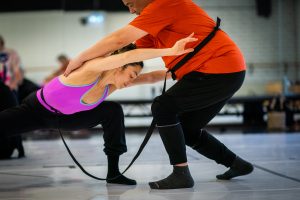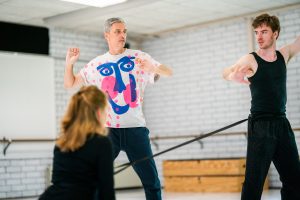Interview by de Volkskrant: Adriaan Luteijn – UNUM
Interview by de Volkskrant: Adriaan Luteijn – UNUM
In this performance, physically distinctive dancers perform with their parents: ‘It has to spark’
May 20, 2025
By: Annette Embrechts
With an inclusive group of dancers—with and without physical disabilities—and their parents, Introdans will perform this Wednesday at the World Expo in Osaka. De Volkskrant observed the preparations by choreographer Adriaan Luteijn, whose direct approach is something the Japanese are not accustomed to.
“No, I never want to know why someone is in a wheelchair, missing a limb, has Asperger’s, or brain damage. That clouds my perception of their movement abilities. I’m not interested in what someone can’t do—I look at what they can do.”
That sounds like a well-meaning statement. But for choreographer Adriaan Luteijn (61), the driving force behind interactive encounters and inclusive projects at Introdans, it’s more than that: ignoring someone’s background is sacred to him when casting. “I don’t want to be held back by medical histories, impairments, or traumas. Often, participants don’t mention those things themselves either. Why should they? Guest dancers don’t know everything about me or the professional Introdans dancers either.”
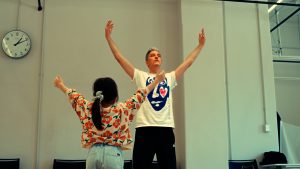
Gaining International Attention
For 25 years, Luteijn has created acclaimed productions with professional dancers and guest performers at the Arnhem-based company—people with muscular diseases, autistic youth, elderly LGBTQ+ individuals, wheelchair users, drag queens, top athletes, and many others. His approach is now gaining international recognition. After collaborations in China, Indonesia, Brazil, and South Africa, Introdans, led by Luteijn, is now touring Japan.
The world premiere of his new work Unum takes place at a special venue: on Wednesday, Introdans will open the Dutch National Day at the five-yearly World Expo in Osaka (Japan). Each of the 160 participating countries designs its own pavilion for the six-month exhibition, centered on innovation and new technology. Each nation is given one day to use the main stage theater.
Paralympic Athlete with Short Legs
After UNUM premieres in Osaka, Introdans will tour the piece in Kobe and Kyoto, adding solos, duets, and the Japanese version of Luteijn’s group piece Iungo. Both feature dancer Kazuyo Morita, who was born with spina bifida (open spine) and scoliosis (spinal curvature).
Also performing in *Unum* is wheelchair dancer and aerial acrobat Kenta Kambara. The Paralympic athlete, born with short legs, is known in Japan as “Superman.” This is all made possible through collaboration with Land Fes, a small Japanese inclusive performing arts festival founded in 2011 by Dai Matsuoka.
“Honestly, I initially struggled with Japan’s traditional politeness.”
Like Luteijn, Matsuoka creates choreography for performers with diverse physical abilities, including Kambara and Morita. In Unum, 38-year-old Kambara will dance for the first time on stage with his 9-year-old daughter, Shiori. Morita will perform with her 74-year-old mother, a university professor.
Luteijn and Matsuoka assembled this Dutch-Japanese cast via an overseas exchange. But it took some time and effort back in Arnhem to get there.
The Start
By chance, Bas Valckx, cultural affairs coordinator at the Dutch embassy in Tokyo, saw the show Nest during a work visit to Arnhem in 2022. Luteijn had created Nest as a dance meeting for Introdans dancers and their parents. Shortly before that, he had received rave reviews for his female trio Pro Forma (2021), featuring Introdans dancer Elena Pampoulova, plus-size dancer Liza Wubbels, and presenter/writer Eva Eikhout. Eikhout was born with the rare FFU syndrome: short arms without hands, short legs without knees, and feet attached to her upper thighs.
“Bas had tears in his eyes after Nest,” Luteijn recalls. “He invited us to pitch an idea for the World Expo in Osaka.” After months of discussions, Introdans received the green light in 2024: the Luteijn-Matsuoka creation Unum would kick off Dutch National Day in the presence of King Willem-Alexander.
Changing Perceptions
“With Introdans, we don’t just want to show remarkable work in Japan—we also want to share our approach, experience, and knowledge, so people there can build on it,”* Luteijn says in January at the Introdans office in Arnhem. He shows videos of the first online meeting between the Dutch and Japanese casts of UNUM.
“In Japan, Dai struggles with the perception that an inclusive cast falls under care or social services rather than art. That used to be the case in the Netherlands too. But after 25 years of pioneering, we’ve made sure that these encounters are now seen as artistic projects.”
Luteijn remembers a sneering remark from an audience member after his first production, Wheelchair Giselle, was included in a major Introdans gala in 2001. *“I overheard someone complain that they didn’t come to the theater to watch screaming spastic kids. What felt natural to me, coming from projects with students in special education, was still unfamiliar to some Introdans audiences. I decided to make my choreography look more exciting and attractive. It needs to have the same flair as our regular repertoire. But it can still be edgy—it should spark, it should crackle. That’s my fuel.”*
Attitudes Toward the Elderly in Japan
For the world premiere, Luteijn brainstormed with Introdans’ artistic director Roel Voorintholt about the Expo themes “sustainability” and “common ground.” *“We interpret ‘a sustainable common ground’ as one’s place of birth, the bond between parent and child. That connection is always there, even if it changes or becomes damaged over time,”* he says on the way to the dance studio on Vijfzinnenstraat.
“Japan, like the Netherlands, faces high healthcare costs due to an aging population. But their treatment of the elderly is very different. There’s a strong social expectation to care for older relatives and show respect. Here, we rely more on collective systems—which are under pressure.”*
Luteijn finds it striking that older people in Japan stay vital longer, despite having the oldest population in the world—nearly 30% is over 65. *“Here, youth and attractiveness are the ideal. In Japan, wrinkles command respect. I find those cultural contrasts fascinating to explore. That’s why Dai and I created an intergenerational cast of six duos: professional dancers with family members. Sustainability also means social interaction between generations.”*
Four Japanese Parent-Child Duos
Luteijn selected two Introdans dancers with their parent in the Netherlands: “I mostly select based on curiosity.” Canadian Angelica Villalon (35), with Introdans since 2013, is dancing with her Filipino-Canadian father Reynaldo (65), a recently retired doctor and surgical assistant. *“Always handy to have a medic along on tour,” Luteijn laughs. “Angelica’s father sees this as a rare chance to experience up close the sacrifices his daughter makes for this demanding profession.”
“Adriaan asks a lot, dares to go far, and clearly states what he finds beautiful or ugly, useful or not. We’re not used to that level of directness in Japan.”
And Dutch dancer Mark van Drunick (25), with Introdans since 2021, is performing with his mother Anne (56), a dance teacher with her own studio in Zevenaar. “Mark took daily dance lessons from her as a child. Now, she’s stepping into his domain.”
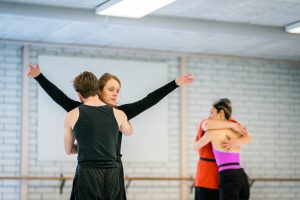
Matsuoka brought together four Japanese duos, he explains via Zoom. A ballerina from the Sadamatsu-Hamada Ballet Company with her surprisingly athletic father. A fellow ballet dancer with his elderly mother. Kambara with his daughter Shiori, and Morita with her intellectual mother.
How old are the parents dancing for the first time? *“We don’t really ask that in Japan. Just like we don’t easily talk about disabilities.”
The Process
Through his collaboration with Luteijn, Matsuoka only learned how participating ballerina Koumi Yamamoto came into the world on the day her grandmother—her father’s mother—passed away. “He has a special bond with Koumi because he sees her as a reincarnation of his mother. This came up thanks to Adriaan’s direct approach to creating dance scenes based on emotional memories. Adriaan demands a lot, dares to push boundaries, and clearly states what he finds beautiful or ugly, what’s usable and what’s not. We’re not used to that kind of directness in Japan. But it yields a lot.”
Introdans director Roel Voorintholt emphasizes how important it is to share knowledge and international experience in inclusive work. “It’s incredibly eye-opening.”
“To be honest, I struggled at first with Japan’s traditional politeness,” Luteijn says after returning from Japan in early May, during a rehearsal week with the Dutch part of the cast in Arnhem. “Dai always says ‘very interesting,’ even when he doesn’t like an idea.”
“Only when I press him during meals—since socializing in Japan happens over lunch or dinner—does he cautiously mention which fragments he finds challenging. The Dutch are more blunt and direct, tell edgier jokes. I provoke by creating obstacles. I try to push people to the edges of their capabilities. Within Introdans, I’m not called the ‘Friendly Forcer’ for nothing.”
Tough Assignments
During rehearsals, the Friendly Forcer indeed gives both Introdans dancers and their parents demanding tasks to create intensive duets about experiences such as rebellious behavior, the difficulty of letting go, the death of a parent, or empty nest syndrome. They yank hard at imaginary umbilical cords, carry each other on their backs, toss each other’s legs in the air, and drop to their knees.
“I always have everyone, regardless of their dance experience, come up with their own solutions to the movement challenges they face. Afraid of hurting someone during a lift? Just ask where you can hold them. Is a wheelchair in the way? Figure it out. If you get tangled up, work your way out. If someone forgets a phrase, show me how you handle it.”
Luteijn wants to avoid the professional dancers holding back or constantly compensating for the missteps of the less experienced performers. “Every participant must feel responsible for the danced material. Mistakes are part of the process. Discover their consequences on the floor and solve them. Most participants find that scary at first, but ultimately liberating.”
“Beautiful mistake! Try it again!” is a frequent encouragement heard in the Arnhem studio as Luteijn rehearses with father-daughter duo Villalon and mother-son duo Van Drunick. “Don’t act. No tender arm contact. Grab each other firmly and swing each other over your back. This isn’t ballroom dancing.”
Pushing Physical Boundaries
Luteijn rehearses until sweat pours from bodies and knees are bruised. “I’m naturally impatient. I’ve had to learn not to lose my patience. If a lift involving a dancer with cerebral palsy takes fifteen minutes, I’ll literally sit on my hands and let them figure out how to speed it up. Afterward, I’ll give tips at most.”
“If they come up with concrete solutions themselves, a bond forms, and they’ll commit fully to that part of the choreography. Then I make sure the lines are clear and remove over-the-top drama, like startled, tense, or sorrowful facial expressions. A choreography should be danced as cleanly as possible, with room for the audience to project their own associations about physical limitations or family relationships. Viewers dismantle their own prejudices. That’s what creates emotional resonance.”
It’s precisely this intense pushing of physical boundaries that drew criticism in Luteijn’s early years. During a segment on the NOS Journaal about his dance project with young, virtuoso male Introdans dancers and older women, journalists anxiously asked whether ambulances were on standby.
“People assume older folks will fall easily. Or they find it uncomfortable to watch performers without legs sliding across the floor like shuffleboard pucks. But they know what they’re doing—and so do I. I don’t like the term ‘inclusive dance.’ I cast inclusively, from all walks of life, ages, and social bubbles, and I simply make dance.”
The Dress Rehearsal
“I’m exhausted,” Luteijn whispers into his laptop screen when we speak to him just before a rehearsal in Japan, three days before Unum’s world premiere. “Of course it’s the jet lag. But the group of twelve has barely been able to rehearse together. Kenta’s daughter is only joining for the first time today—it turns out it’s not easy here either to pull a kid out of school for an art project. I see her struggling with where to enter and exit. Dancers are stepping in to help her, but I actually want to avoid that. Kazuyo is still too cautious with her mother. But we have three days,” he says, tempering his stress.
“It’ll be fine,” Dai laughs, emphasizing how much he’ll miss Adriaan when the project ends in two weeks. They call each other kyodai, the Japanese word for brothers without an age gap. “I’ve learned so much from Adriaan’s bold approach.”
When rehearsal begins, all the dancers wave at the computer screen. “Gezellig!” they call out in unison—the Dutch word most of them find as fun as it is incomprehensible. Then twelve Japanese folding screens slide in and out of view, dancers in red costumes appear and disappear, Kenta slips from his wheelchair and speeds across the floor without legs; his daughter caresses his cheeks. Kazuyo carries her mother, like a distracted professor, on her deformed back. Anne swings her legs high over her son Mark. Angelica embraces the belly of her father Rey.
Outside, sitting on a step with his laptop on his lap, Luteijn exhales and reflects on the question of whom he’d still like to have a familial dance encounter with. His son Benjamin? “I danced with him twelve years ago in Introdans’s Pulcinella. He has talent, but now he’s a music producer. You know, I just became a grandfather. I hope I’ll get to dance with my grandson Aiden someday. He takes after his Surinamese mother. That’s bound to be a surprising combination.”
Unum by Introdans, Land Fes, and Sadamatsu-Hamada Ballet Company opens the Dutch National Day at the World Expo in Osaka on May 21, in collaboration with the Nieuwe Instituut and the Dutch embassy in Japan. Also to be performed on May 24 and 25 as part of a quintet program in Kobe, and on May 27 in Kyoto.
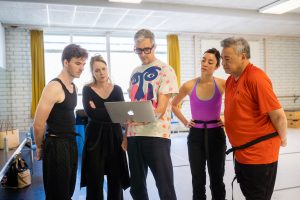
Knight of the Order of Orange-Nassau
Adriaan Luteijn (born 1964, ’s-Heer Arendskerke) studied dance expression education at the Fontys Academy in Tilburg and began his career in 1989 as a dancer with Introdans Ensemble for Youth. In 1998, he continued there as a choreographer. In 2003, he received the Encouragement Award from the Dansersfonds ’79, and five years later, the Kunstfactor Dance Lifetime Achievement Award. In 2018, he was knighted in the Order of Orange-Nassau, and this past March he received the Gelderland Cultural Award from the Prince Bernhard Culture Fund, worth 15,000 euros. Luteijn lives in Arnhem.
